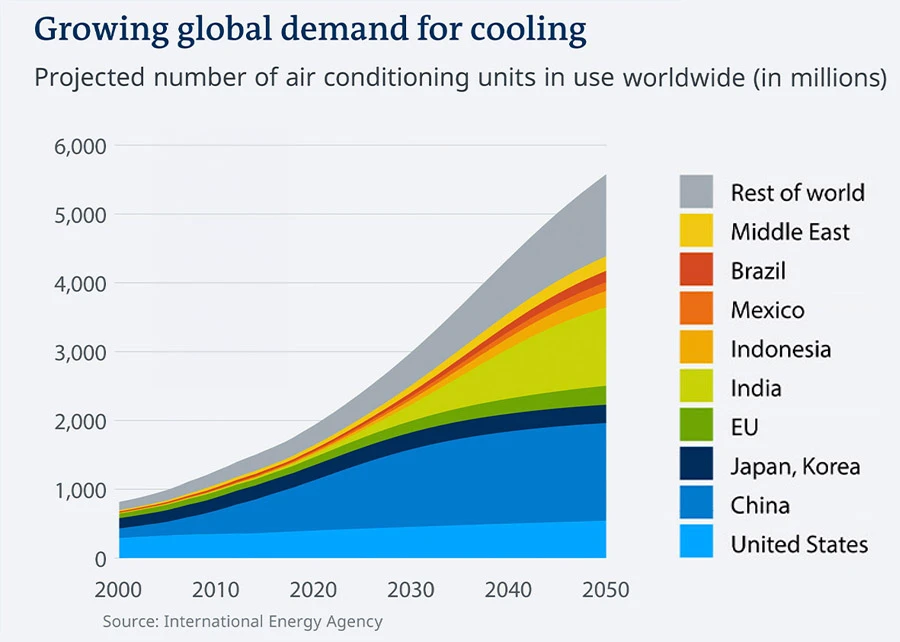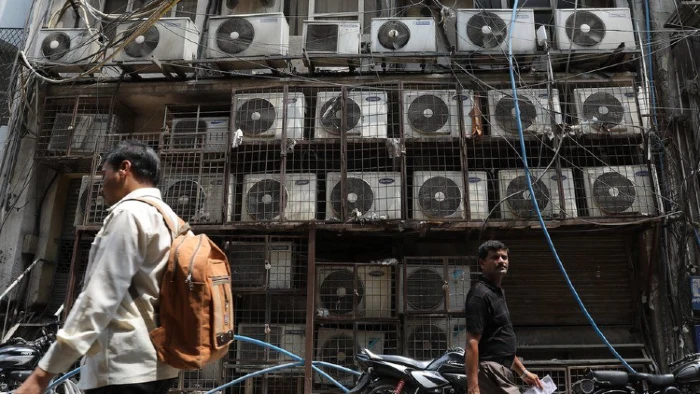In the quest for more efficient and environmentally friendly cooling methods, scientists have made a groundbreaking discovery. A team led by Emmanuel Defay at the Luxembourg Institute of Science and Technology has developed a cooling system that could transform how we maintain comfortable temperatures in our buildings.
The Problem with Traditional Air Conditioning
Currently, air conditioning units are essential in many buildings but are known for their high energy consumption. In fact, cooling systems account for about 20% of the total electricity used in buildings. These conventional units work by compressing and expanding fluids, a process that, while cost-effective and simple, is energy-intensive and often relies on harmful environmental coolants.

The Electrocaloric Cooling Solution
The new technology developed by Defay and his team offers a promising alternative. This system, based on electrocaloric cooling, operates with remarkable efficiency, and doesn’t require harmful refrigerants.
But what exactly is electrocaloric cooling?
What Is Electrocaloric Cooling
- Electrocaloric Effect: This phenomenon occurs when an electric field is applied to certain materials, causing their electric charges to realign. This realignment results in a temporary rise in temperature. When the electric field is removed, the temperature decreases. This cycle of heating and cooling can be harnessed for temperature regulation.
- Efficiency: The electrocaloric system can achieve maximum efficiencies over 60%, nearly double that of standard air conditioning units.
- Environmentally Friendly: Since it doesn’t use traditional coolants, it’s a greener alternative to current cooling methods.
How the System Works
Defay’s team crafted their cooling device using lead scandium tantalate, a metal with electrocaloric properties. By stacking eight strips of this material and immersing them in a heat-conducting silicone oil, they created a system where heated fluid moves in one direction and cooled fluid in another. This creates regions of different temperatures, which can be used to cool or heat spaces as desired.
The Future of Cooling
While the current design’s efficiency is around 12%, the potential is much higher and could be up to 67% more efficient, theoretically. Improvements could be made by finding better heat conductors than lead scandium tantalate.
Neil Mathur from the University of Cambridge applauds the innovative use of thin electrocaloric strips, noting their potential for higher cooling performance due to their ability to withstand high electric fields without breaking down. “A superlative performance has been achieved by combining known elements,” he said.
This breakthrough in cooling technology represents a significant step towards more sustainable and efficient temperature control, particularly to counter the rising energy needs and costs of data centers around the world.
Impact of Electrocaloric Cooling on Global Data Center Operations
To put this conceivable advancement into real world applications, we’re going to examine the fastest growing air-conditioning user on the planet – data centers.
Should the electrocaloric cooling system operate at 50% greater efficiency than traditional air-conditioning (rather than the 67% the researchers hope to achieve) it would have massive transformative impact on global data center operations. Data centers, the backbone of our ever-expanding digital world, are notorious for their high energy demands, primarily due to the need for continuous cooling to keep servers running optimally. And to put their cooling needs into perspective… this isn’t a comfortable home during the summer months, this is the walk-in refrigerator at Costco!
As of April 2023, data centers globally were estimated to consume about 2% of the world’s electricity. This may seem small in percentage terms, but translates to hundreds of terawatt-hours (TWh) annually. And this figure grows year over year.
A significant portion of this energy, estimated at around 44%, is dedicated solely to cooling systems.
If the electrocaloric cooling system operates at 50% greater efficiency, this could lead to a significant reduction in the total energy consumption of data centers. For instance, if the cooling energy requirements are halved, there could be a 20% reduction in the overall energy footprint of data centers.
More To Discover
- Al Dhafra Solar Farm: The World’s Largest Single-Site Solar Farm Shines On The UAE’s Renewable Energy Ambitions
- Philippines Accuses Chinese Fishers of Cyanide Pollution in Disputed Waters
- The Required Innovations in Food and Agriculture for Climate Resilience and To Feed The Future of The World
- Climate Change Rolls Back Decades of Clean Air Progress in U.S., Study Reveals

Alleviating Grid Stress
This reduction in energy demand would directly alleviate stress on energy grids, particularly in regions where data centers are densely located. Less strain on the grid translates to improved energy stability and reduced likelihood of outages.
Lower energy consumption also means a reduction in carbon footprint. This is particularly relevant considering the growing concerns about the environmental impact of massive data centers. Reduced energy use translates to lower CO2 emissions, aligning with global efforts to combat climate change.
Economic Implications Are Substantial
For data center operators, improved efficiency translates to significant cost savings in terms of reduced electricity bills. This could also lead to a competitive advantage in an industry where operational costs are a critical factor. With lower costs comes more investment capital.
The adoption of this technology could spur further investments in green technologies, accelerating the shift towards more sustainable data center operations.
While the technology isn’t there yet, the potential adoption of electrocaloric cooling technology in data centers could mark a significant step forward in reducing global energy consumption, easing the burden on energy grids, and mitigating environmental impacts. The ripple effect of such a technological shift could accelerate the move towards more sustainable and efficient digital infrastructure worldwide.





















